Feasibility of a 12 Week Physical Intervention to Prevent Cognitive Decline and Disability in the At-Risk Elderly Population in Korea
Abstract
1. Introduction
2. Materials and Methods
2.1. Participants
2.2. Assessment of Physical Activity
2.3. Assessment of Physical Performances
2.4. PEI Protocols
2.5. Outcome Measures
2.6. Statistical Analysis
3. Results
3.1. Demographic and Clinical Characteristics of Participants
3.2. Feasibility of the 12 Week PEI
3.3. Changes in Cognitive Function and Physical Fitness after the 12 Week PEI
4. Discussion
Author Contributions
Funding
Conflicts of Interest
Appendix A
| Group Session | Home Session | ||||||||
|---|---|---|---|---|---|---|---|---|---|
| Strength-Intensive | Aerobic Exercise-Intensive | ||||||||
| Exercise category/name | L1 | L2 | L3 | L1 | L2 | L3 | L1 | L2 | L3 |
| Aerobic exercise | |||||||||
| Number walking | ● | ● | ● | ● | ● | ● | ● | ● | |
| Number running | ● | ● | ● | ● | ● | ● | ● | ● | |
| Time to stop | ● | ● | ● | ||||||
| Quiz walking | ● | ● | ● | ||||||
| Crab walking | ● | ● | |||||||
| Spider walking | ● | ● | ● | ||||||
| Jump rope | ● | ● | ● | ● | ● | ● | |||
| Ladder walking | ● | ||||||||
| Step up and down | ● | ● | ● | ● | ● | ● | ● | ● | ● |
| Music walking | ● | ● | ● | ||||||
| Resistance exercise | |||||||||
| Band routine | ● | ● | ● | ● | ● | ● | ● | ● | |
| Chair routine | ● | ● | ● | ● | ● | ● | ● | ||
| Animal walking | ● | ● | ● | ||||||
| Band pull touch | ● | ||||||||
| Crab walking with a band | ● | ● | ● | ||||||
| Balance exercise | |||||||||
| Single leg standing | ● | ● | ● | ||||||
| Touch number | ● | ● | |||||||
| Move towel | ● | ● | ● | ||||||
| Balloon toss | ● | ● | ● | ||||||
| Balloon kick | ● | ● | ● | ||||||
| Finger-and-toe exercise | |||||||||
| Grip | ● | ● | ● | ● | |||||
| Finger stamp | ● | ● | ● | ● | ● | ● | |||
| Okay 2 | ● | ● | ● | ||||||
| Stretching exercise | |||||||||
| Brain stretching | ● | ● | ● | ● | ● | ● | ● | ● | ● |

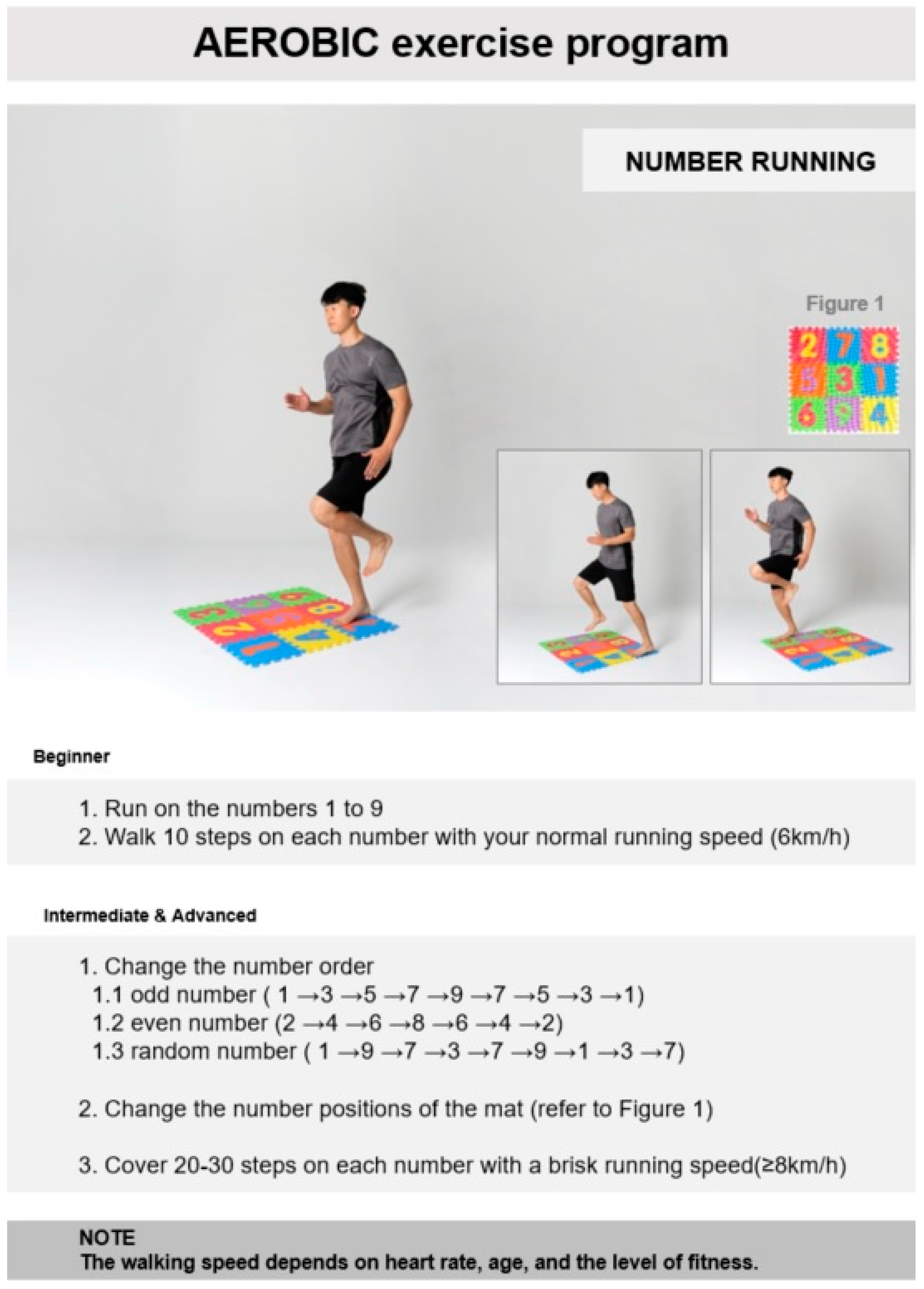

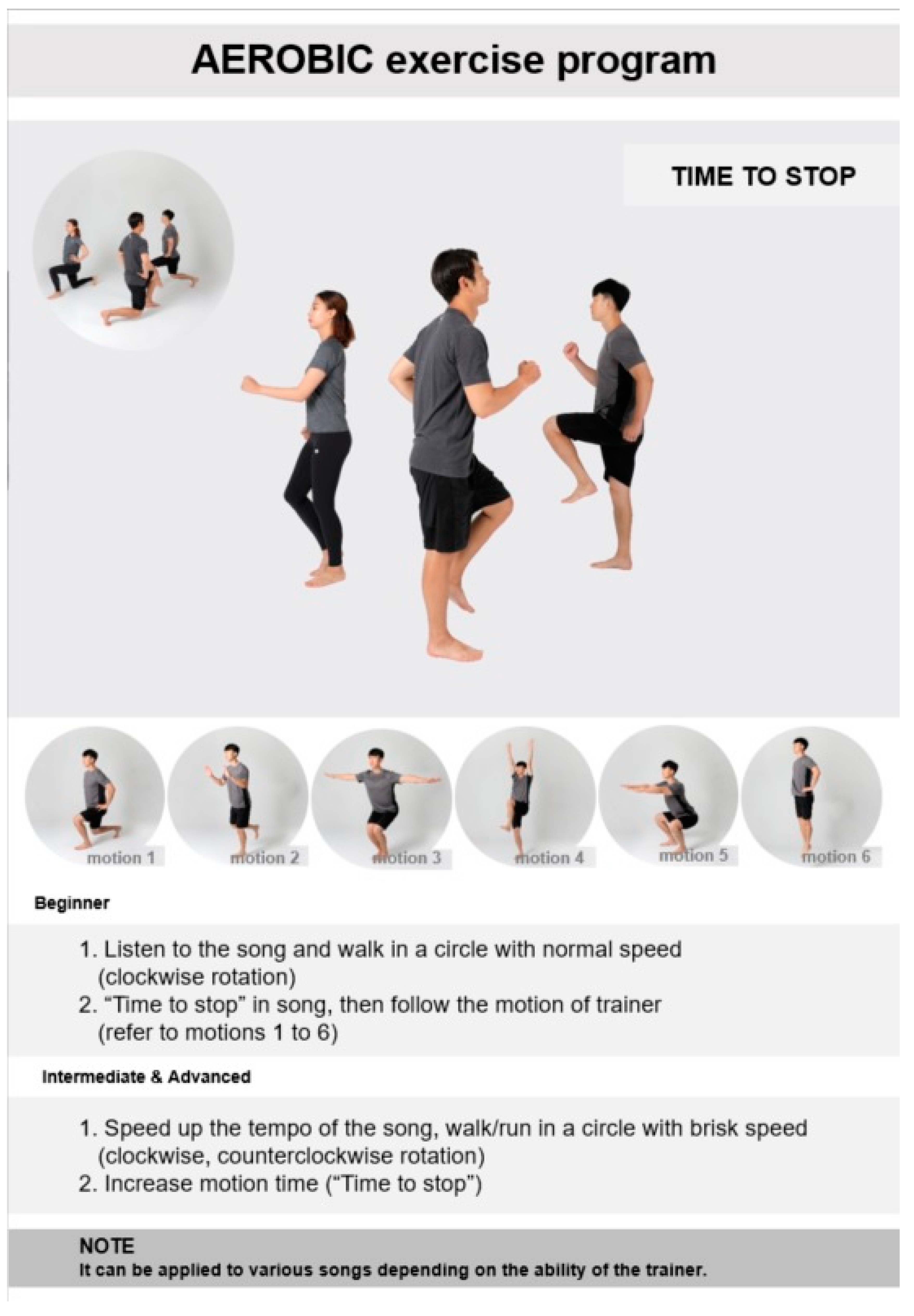
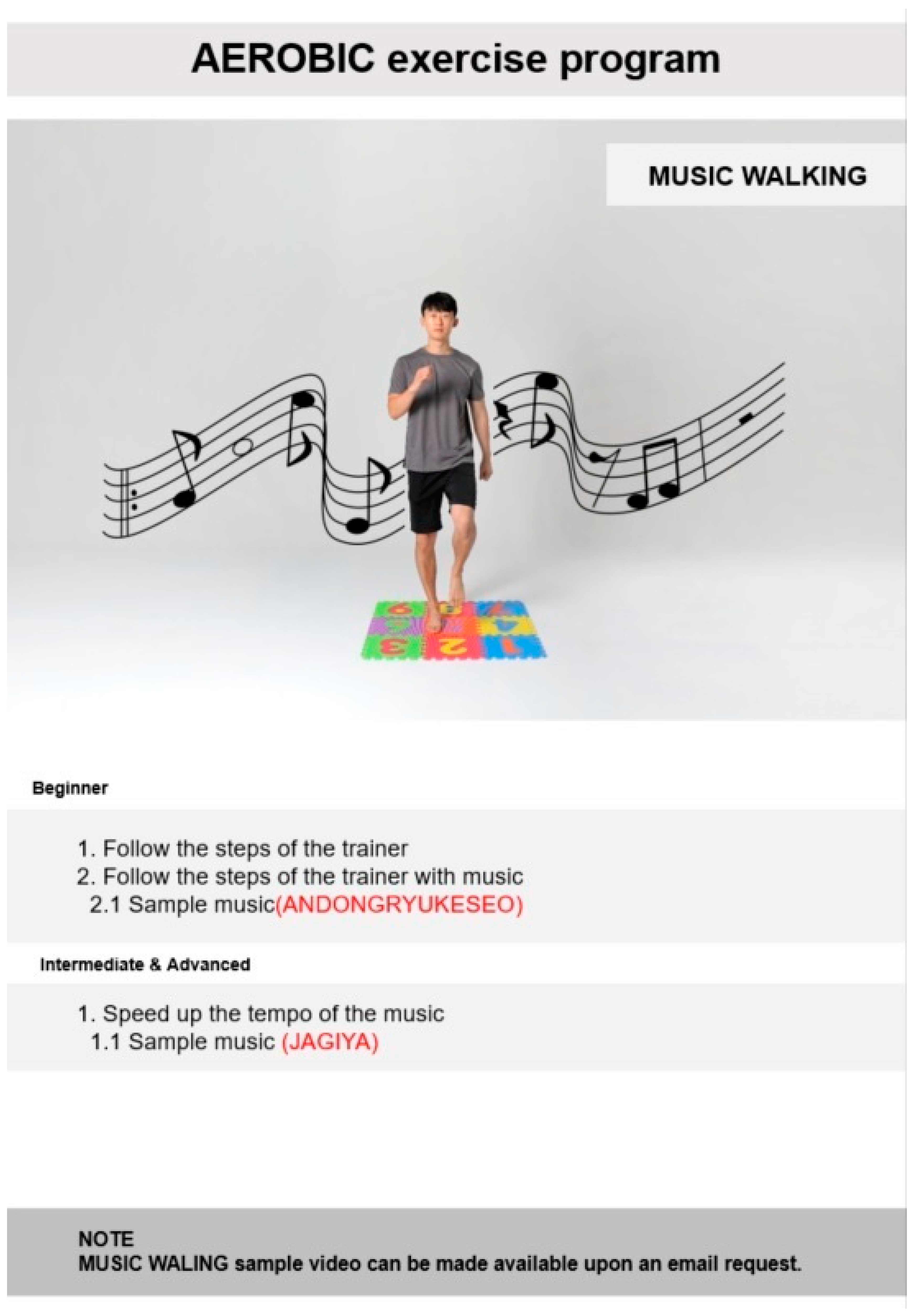
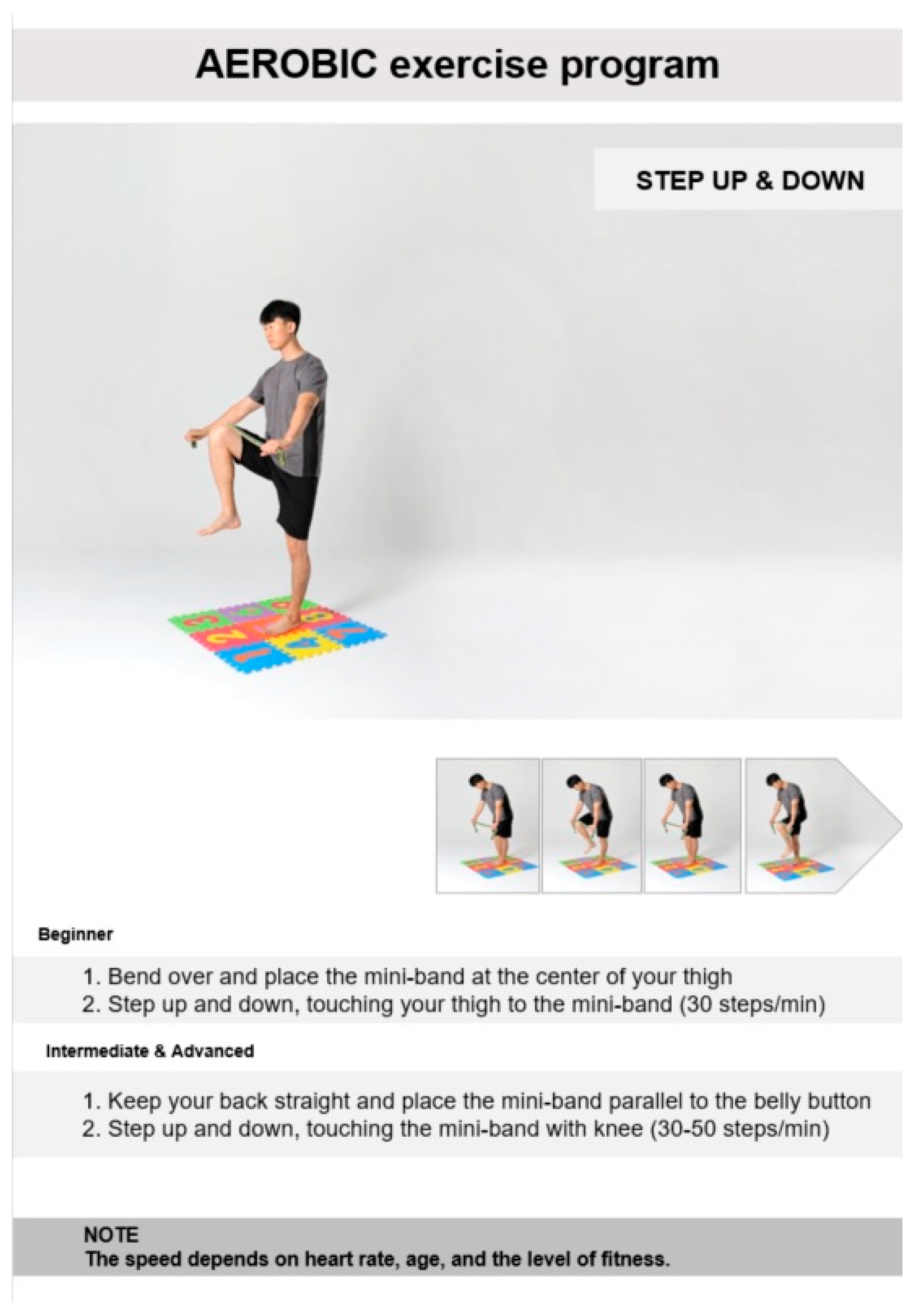
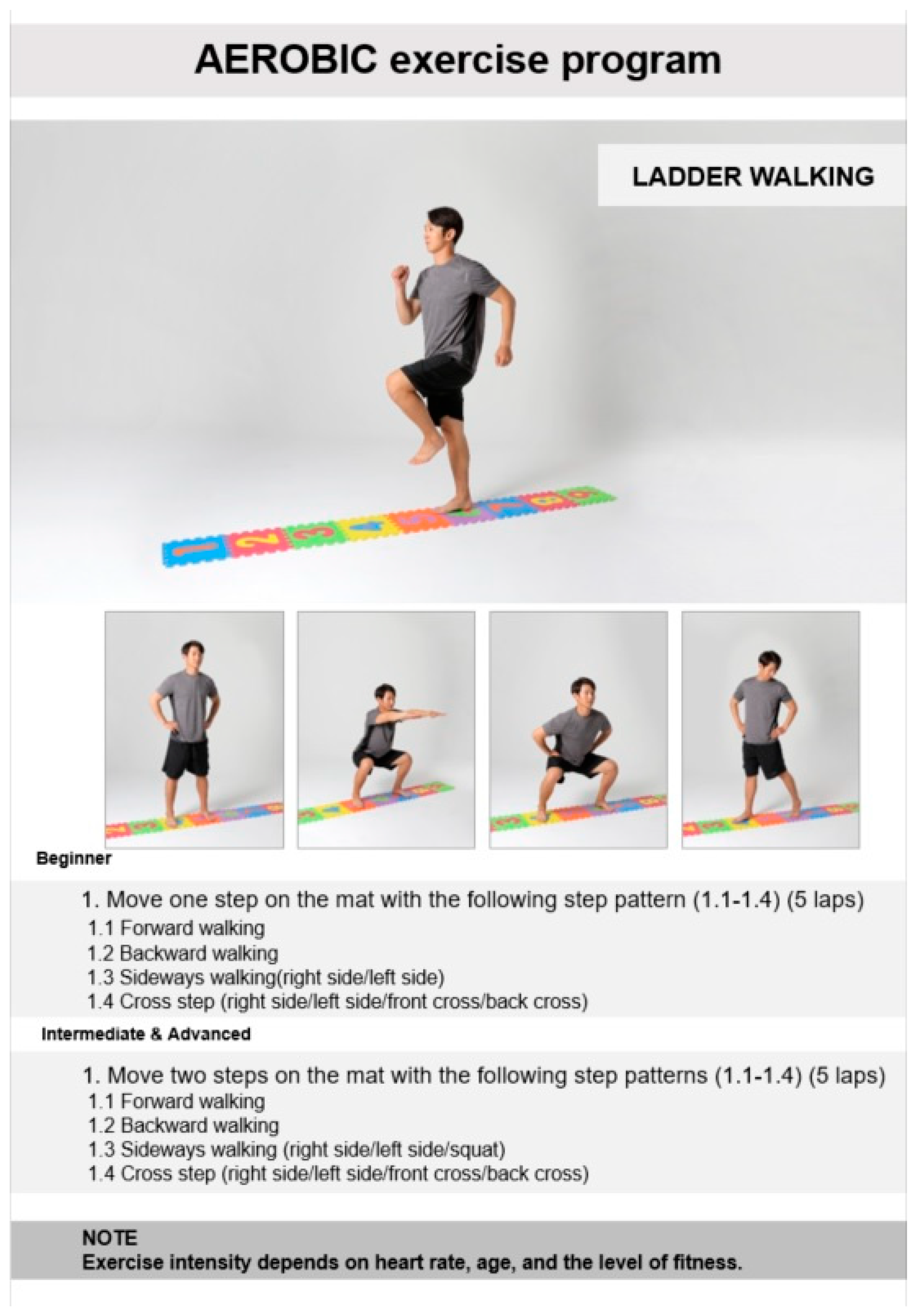
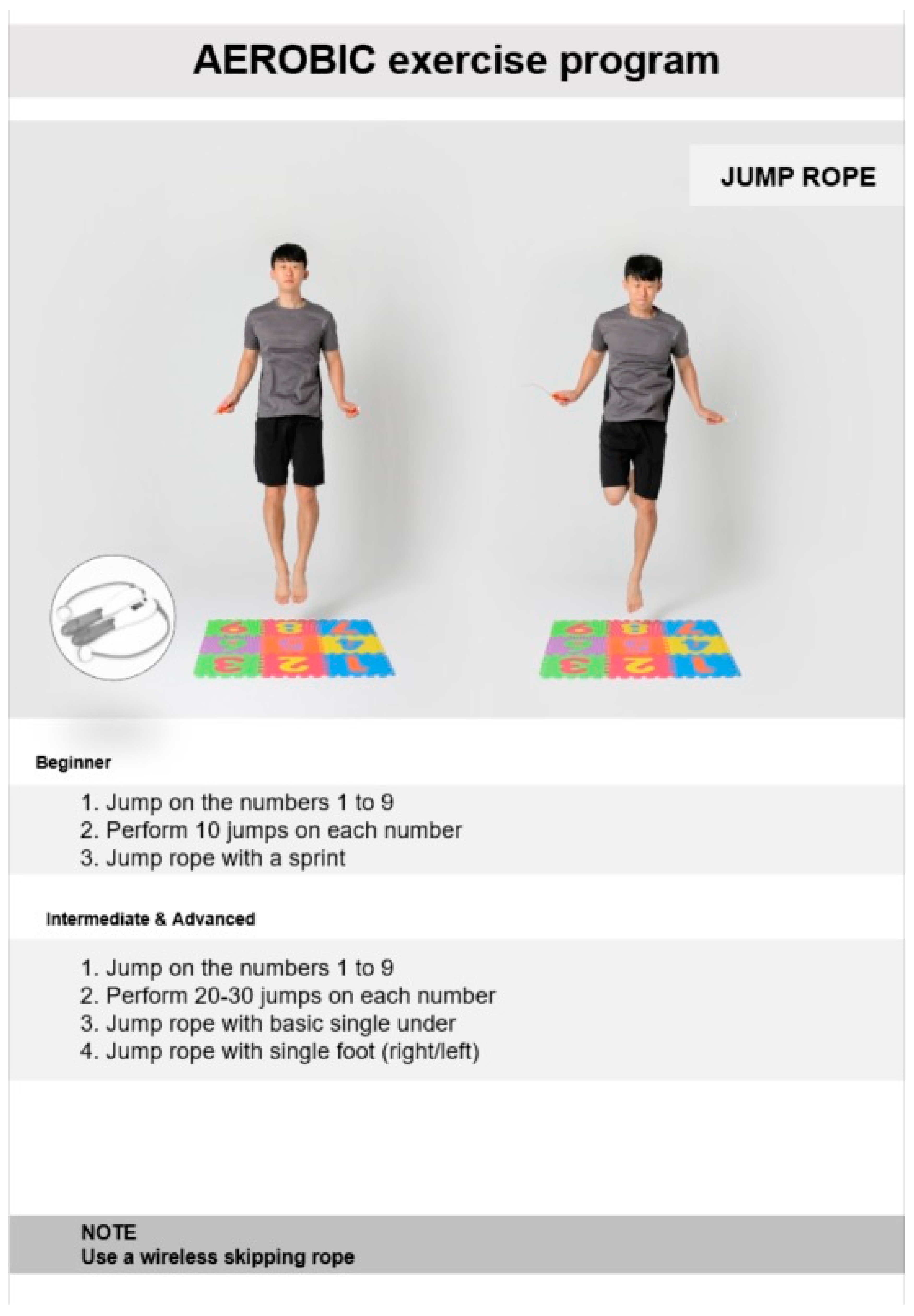
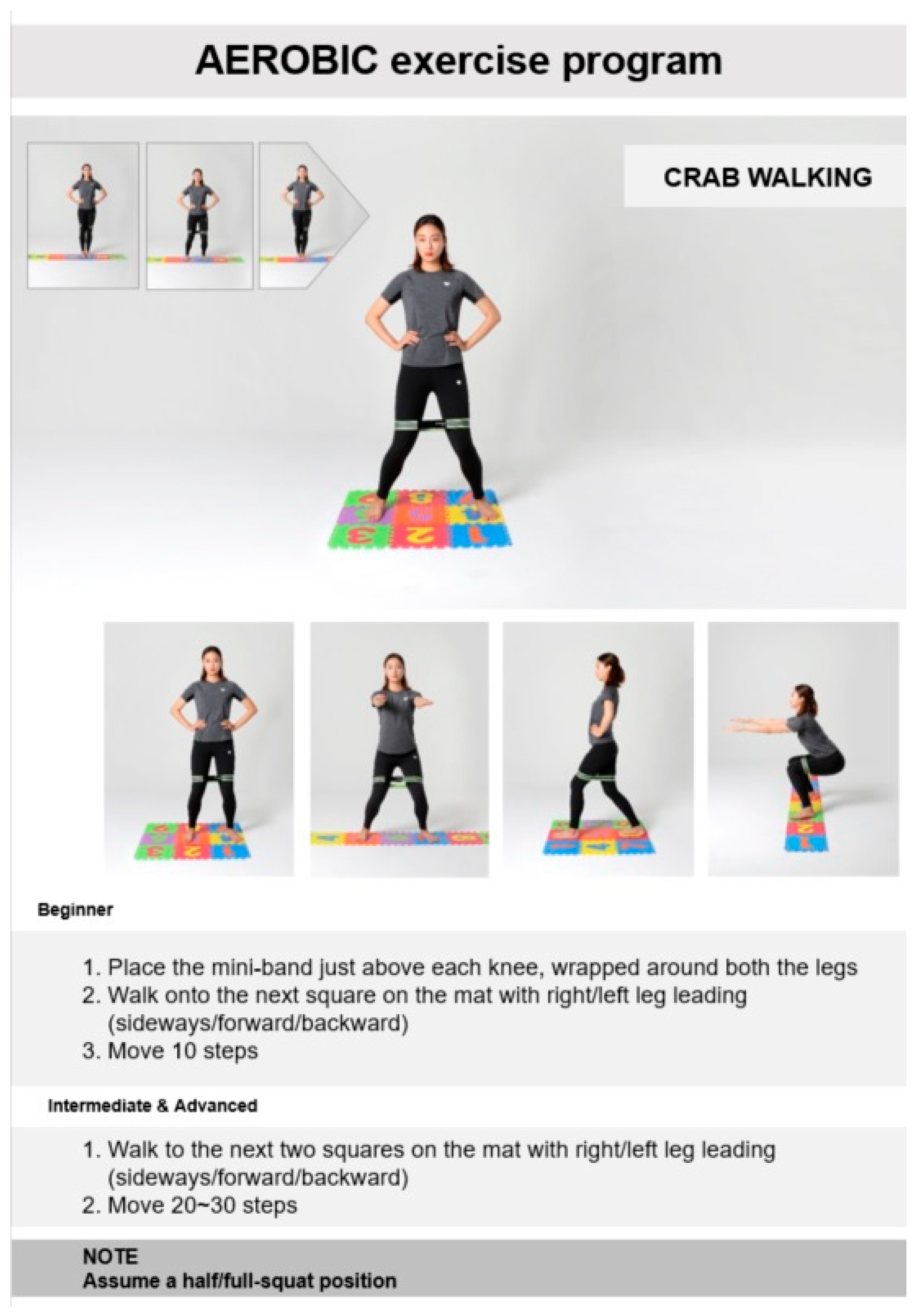

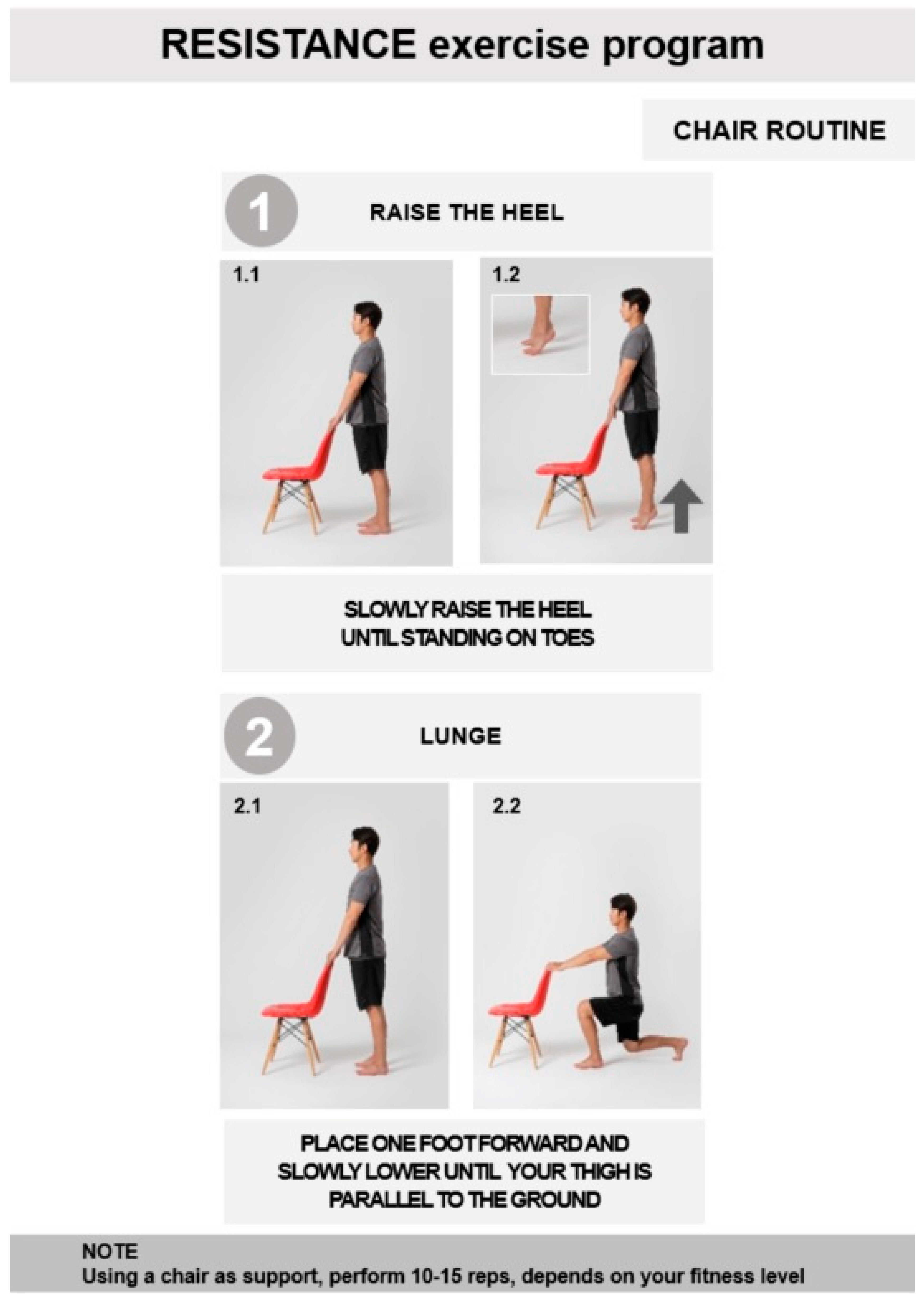
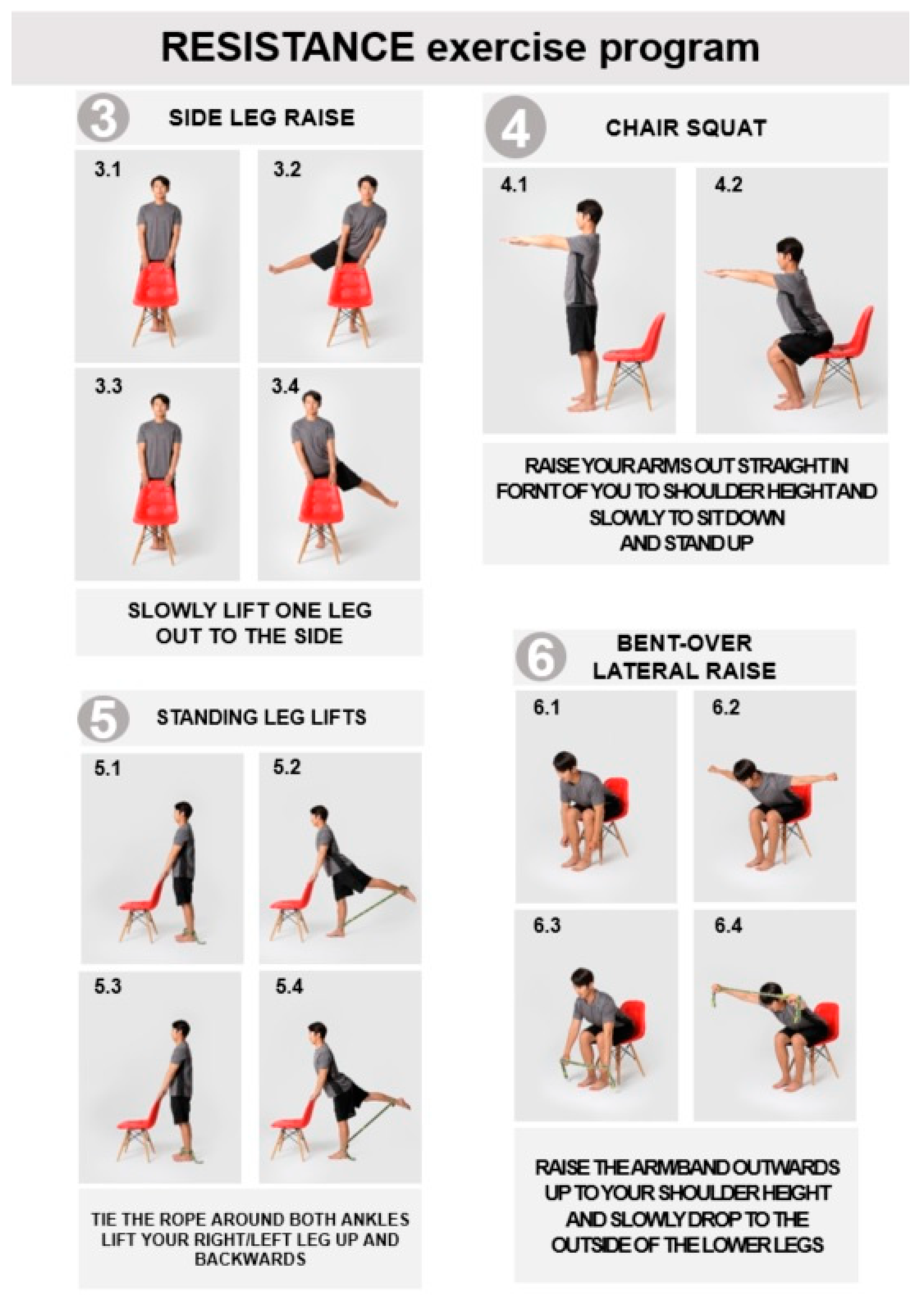
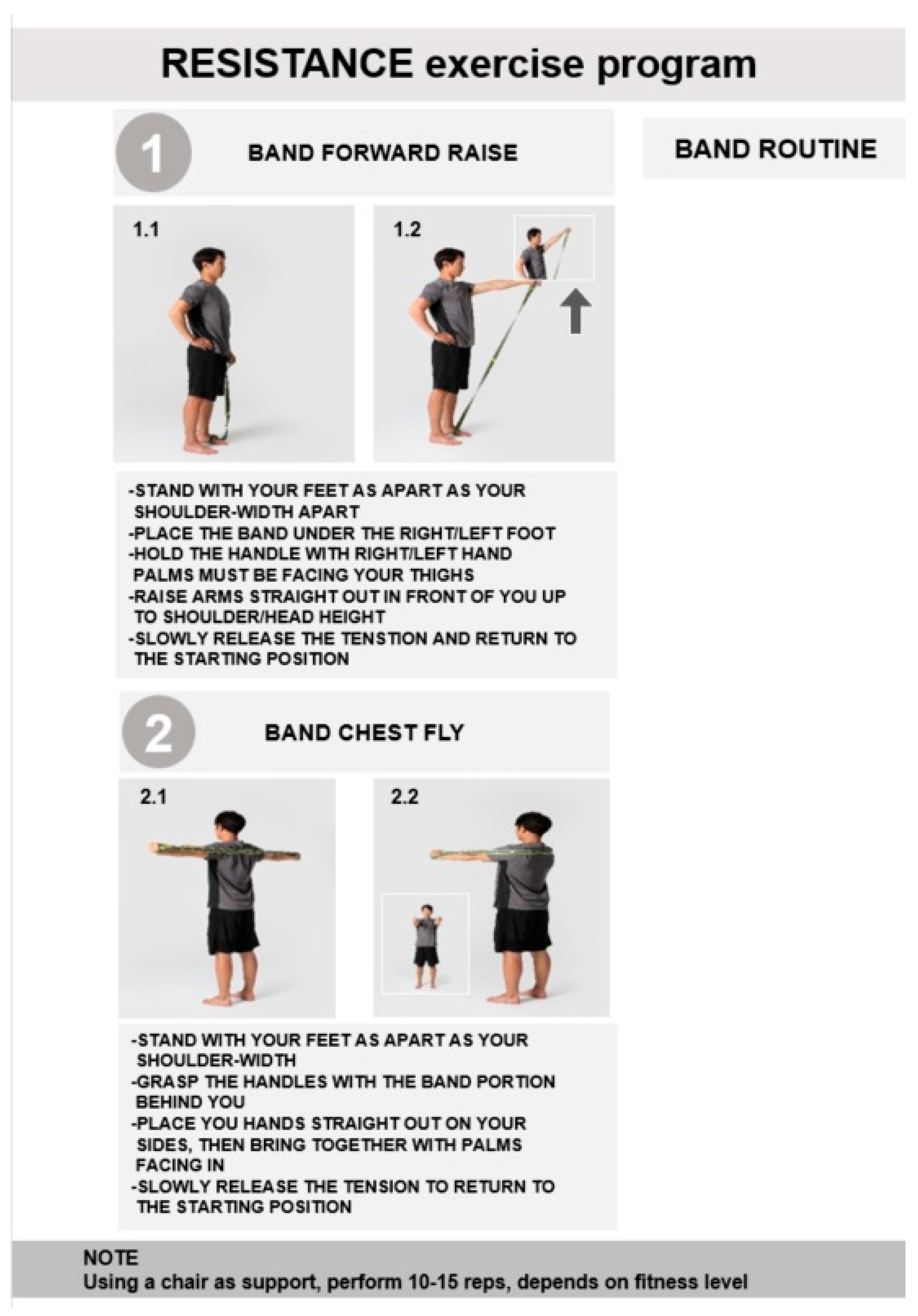

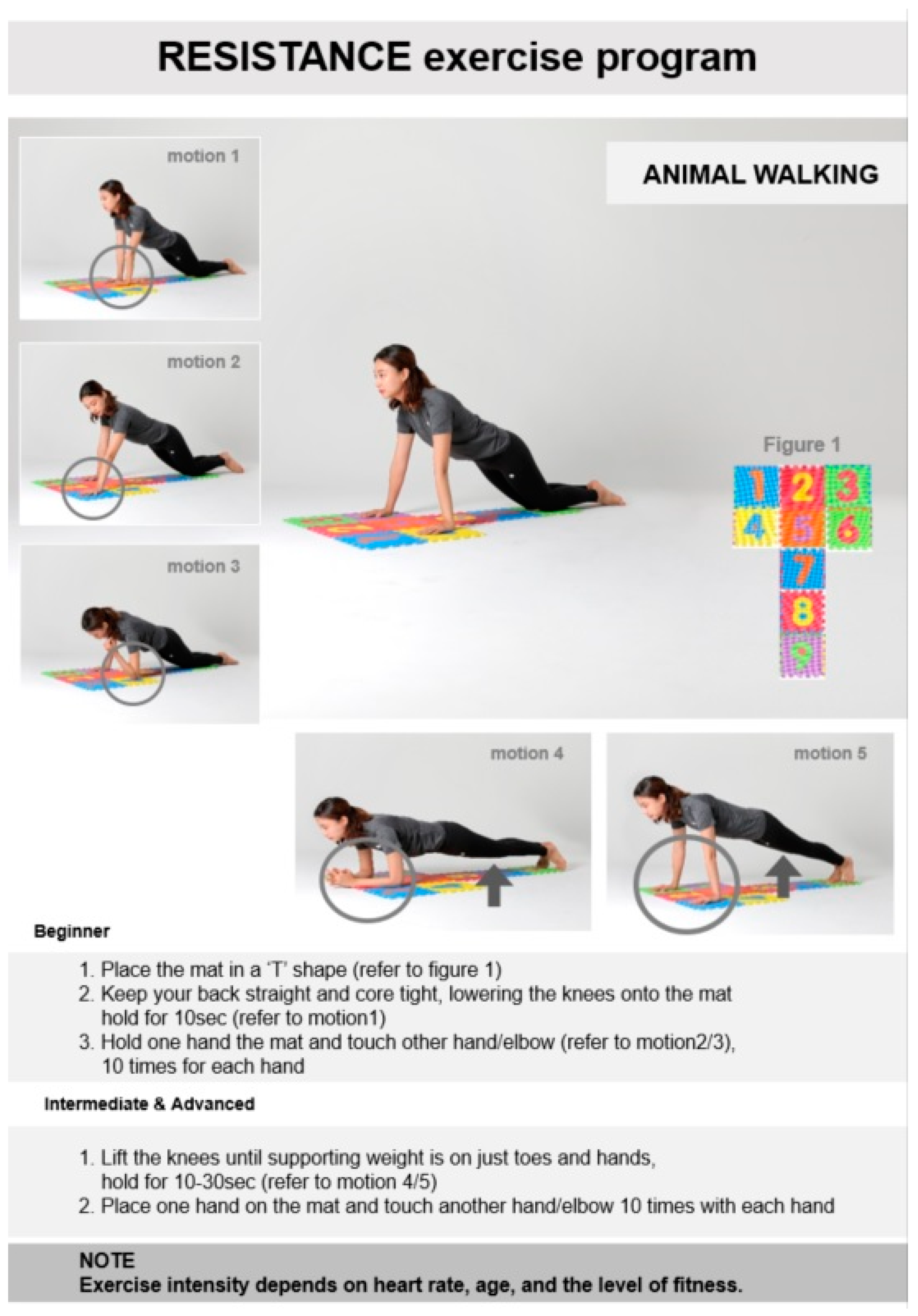
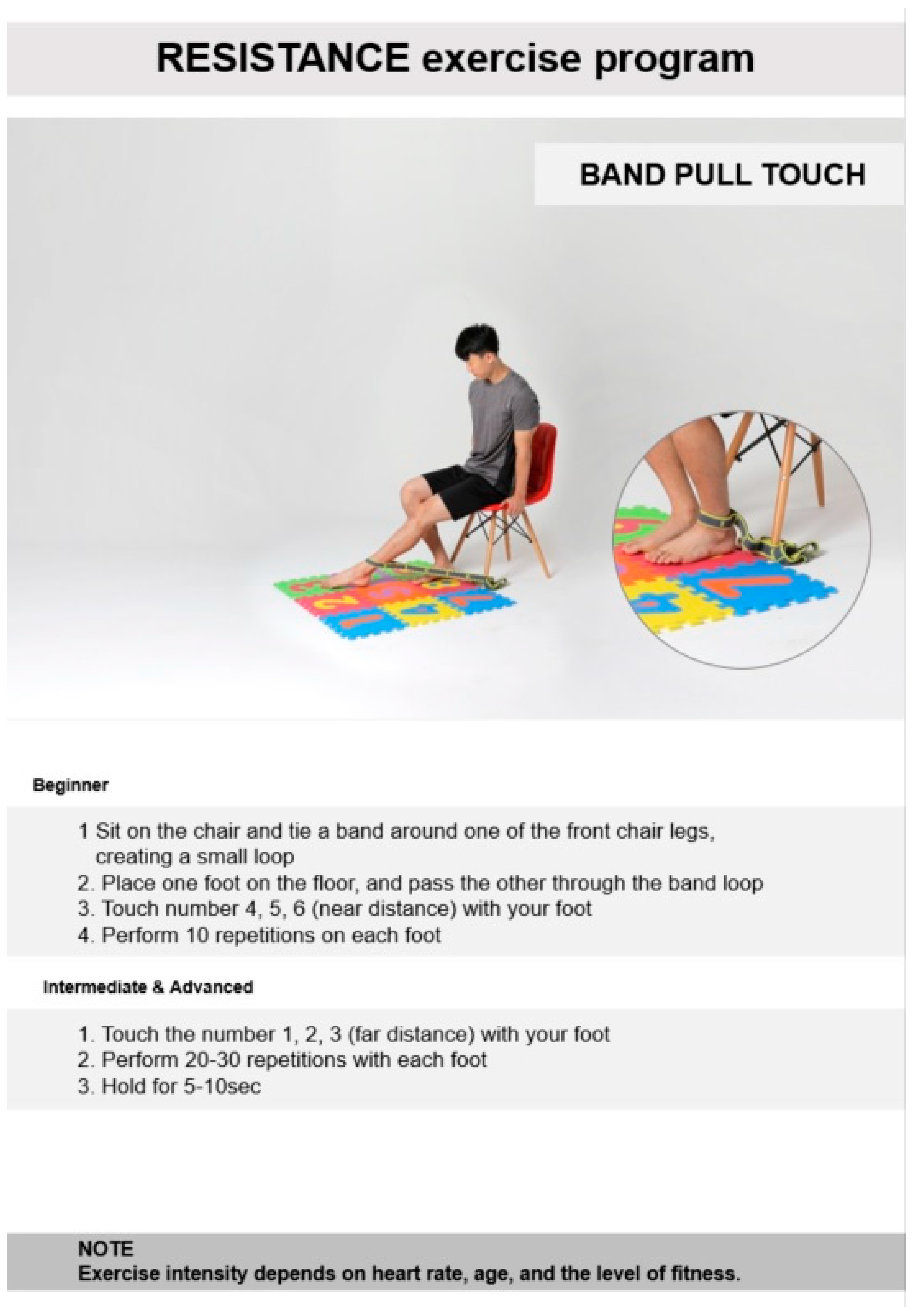

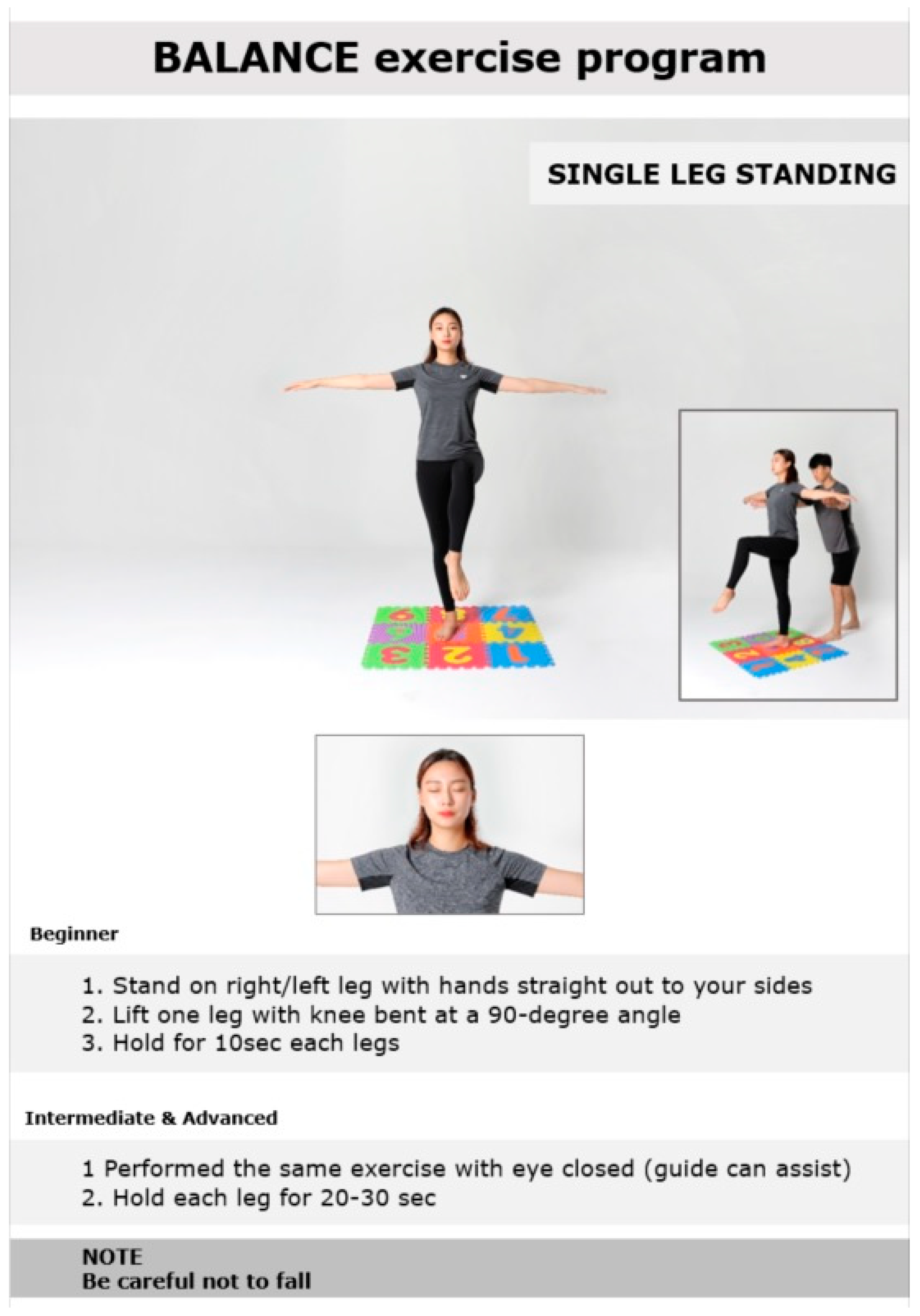
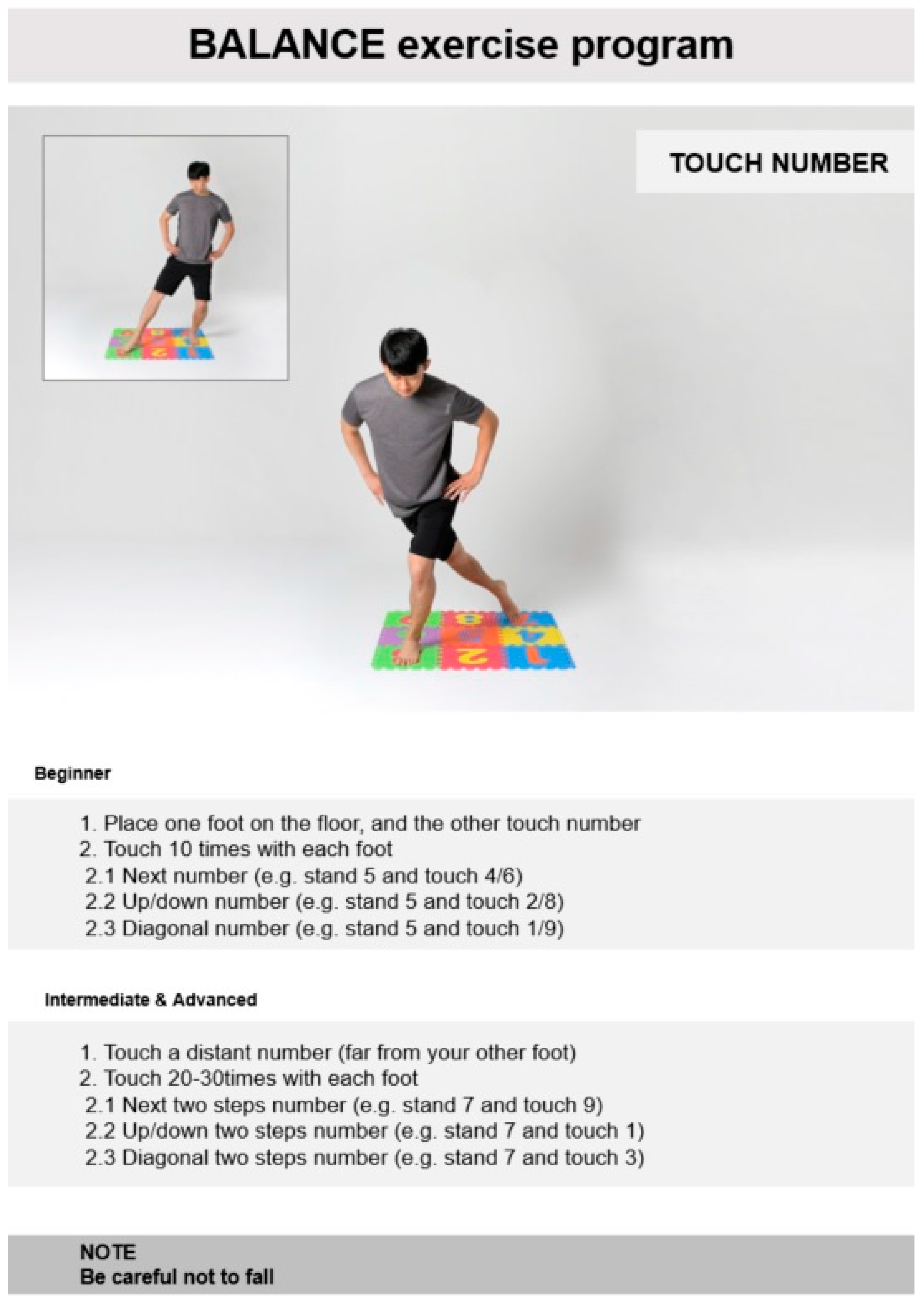
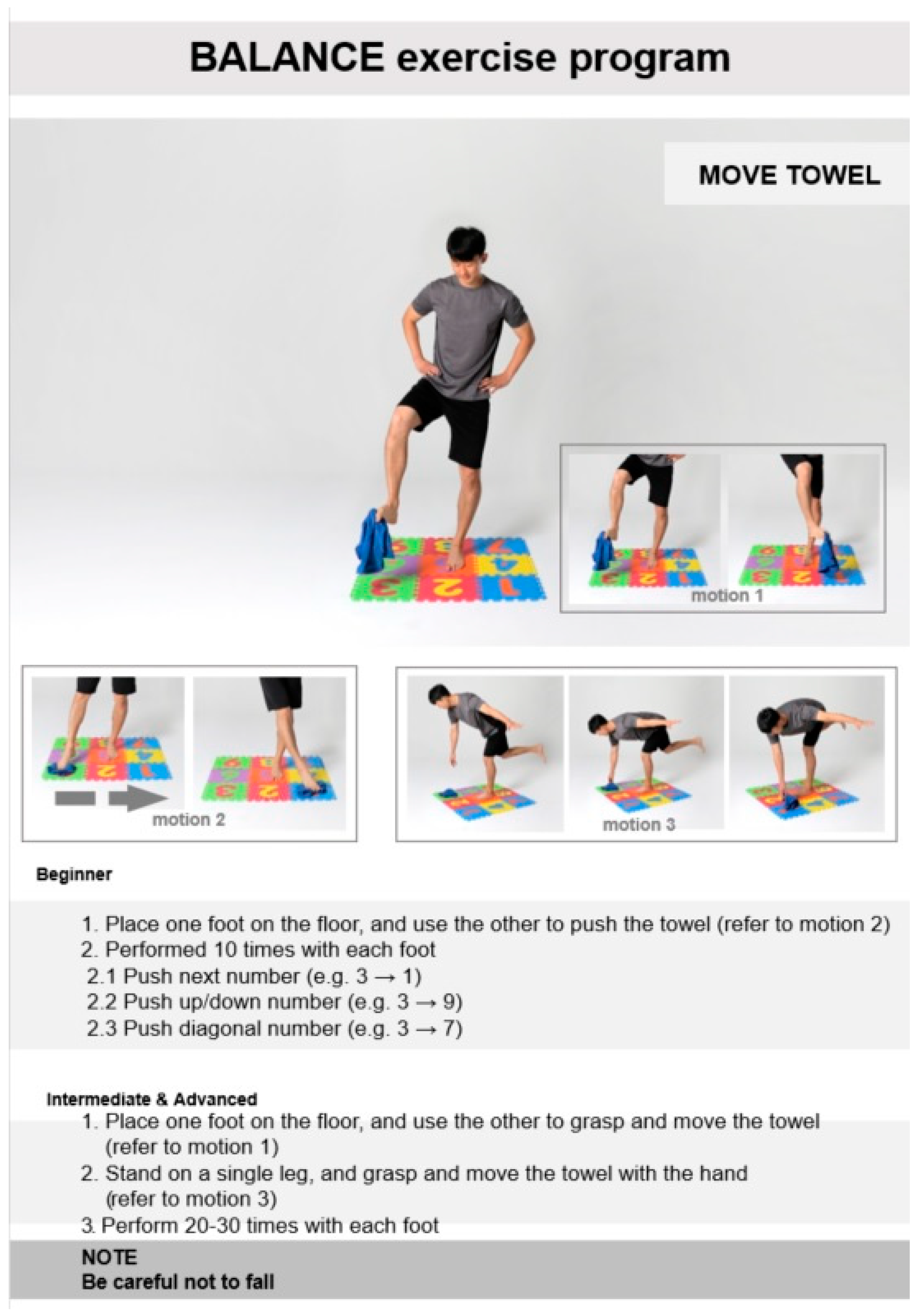
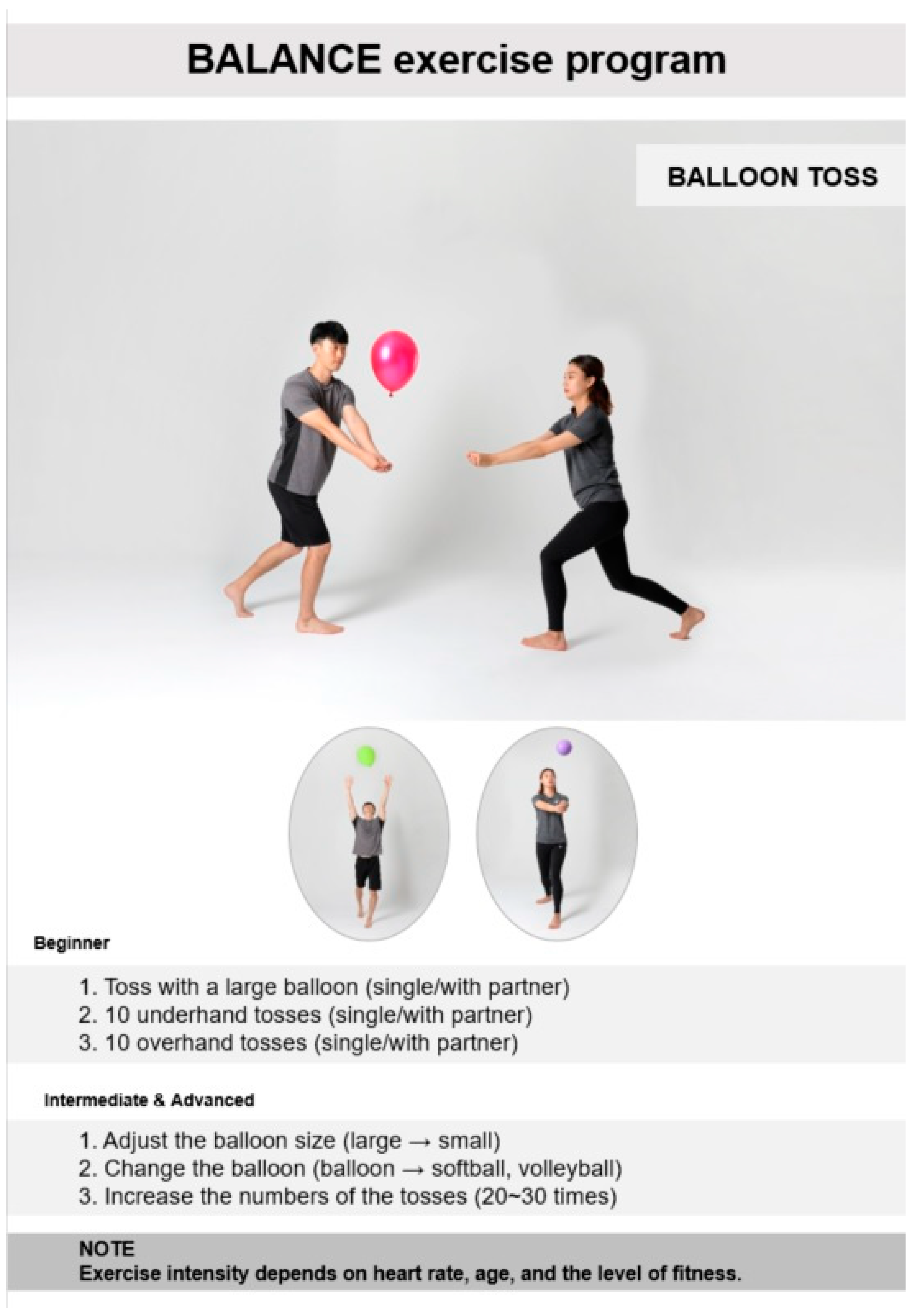
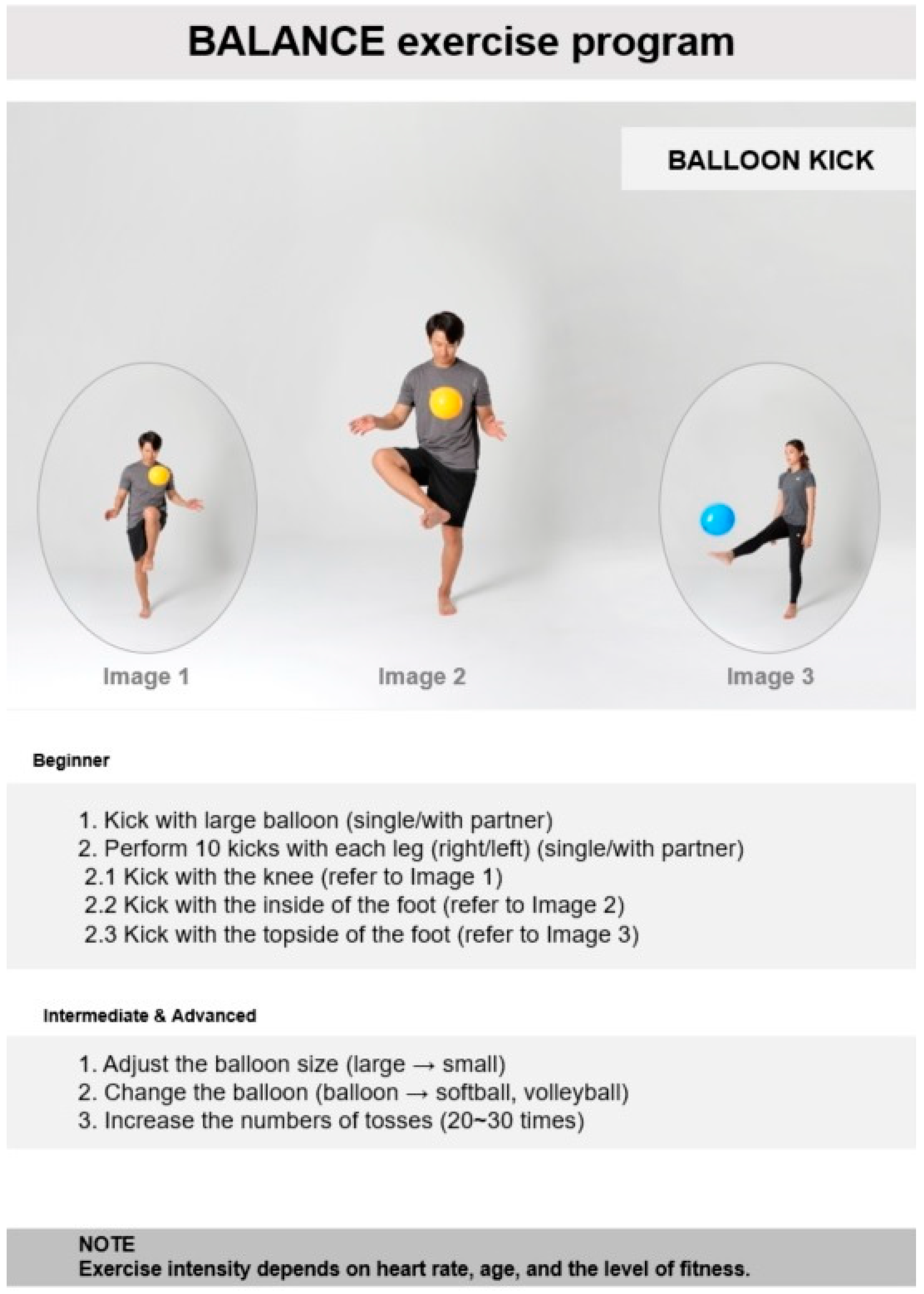
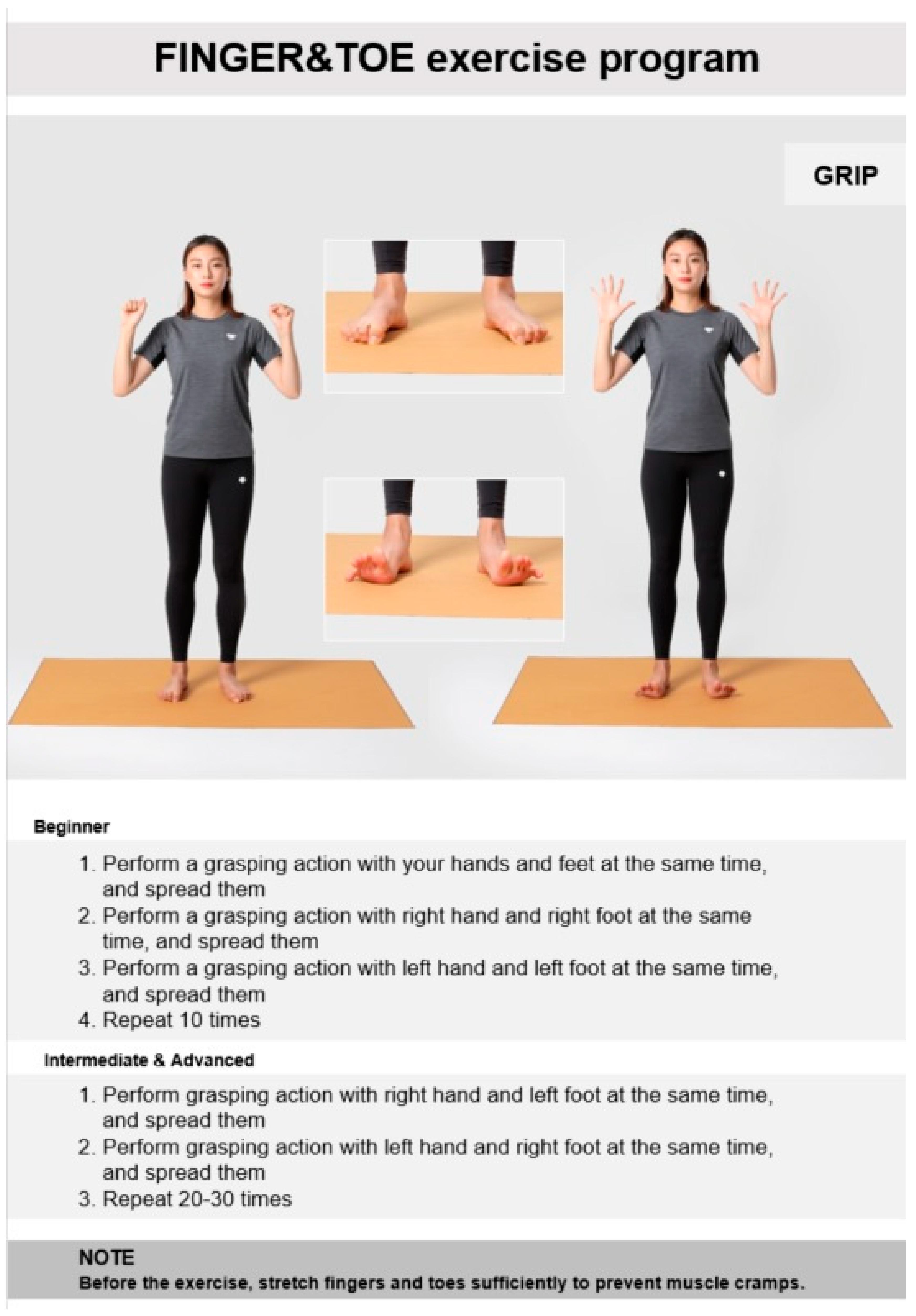
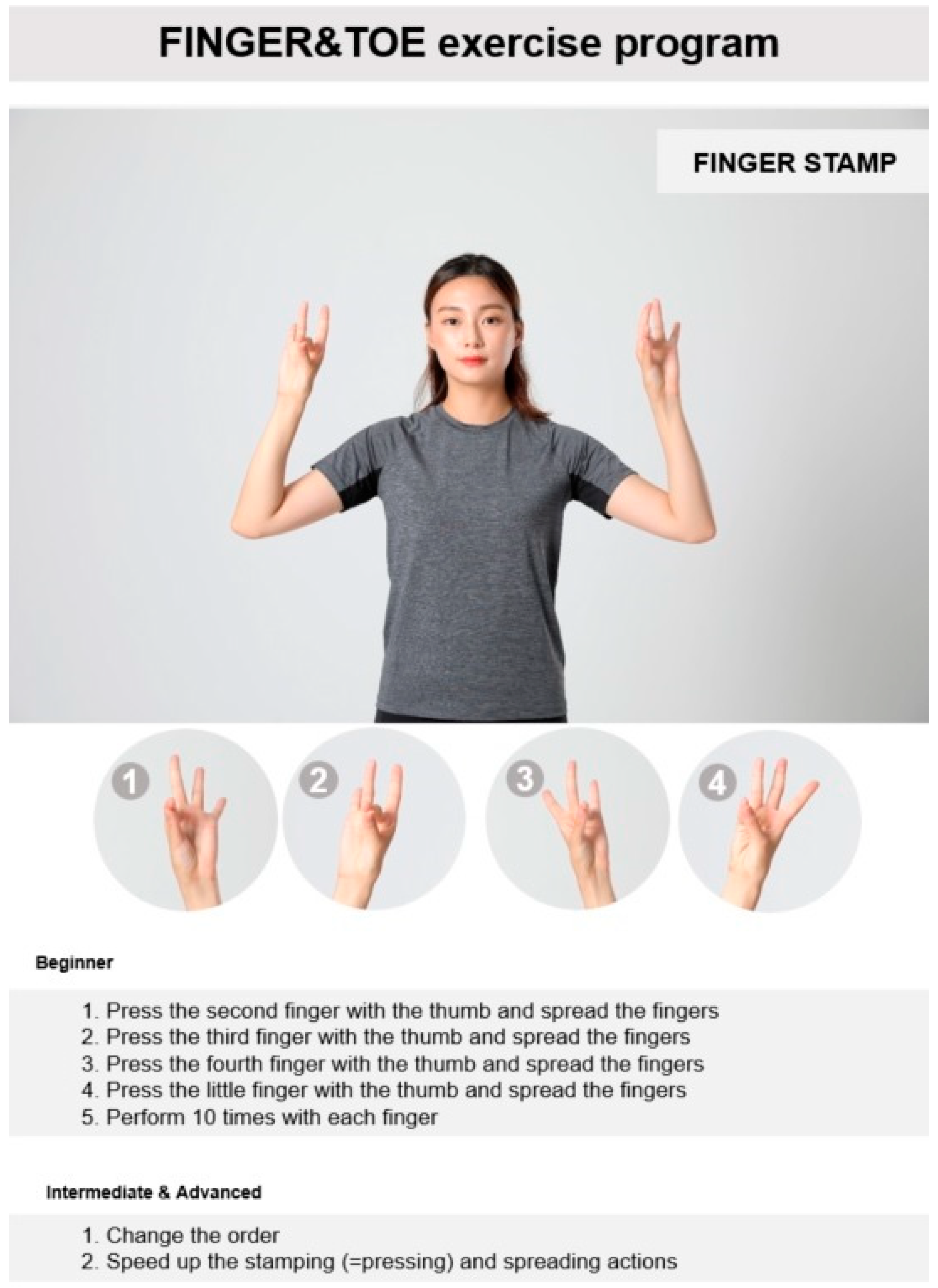
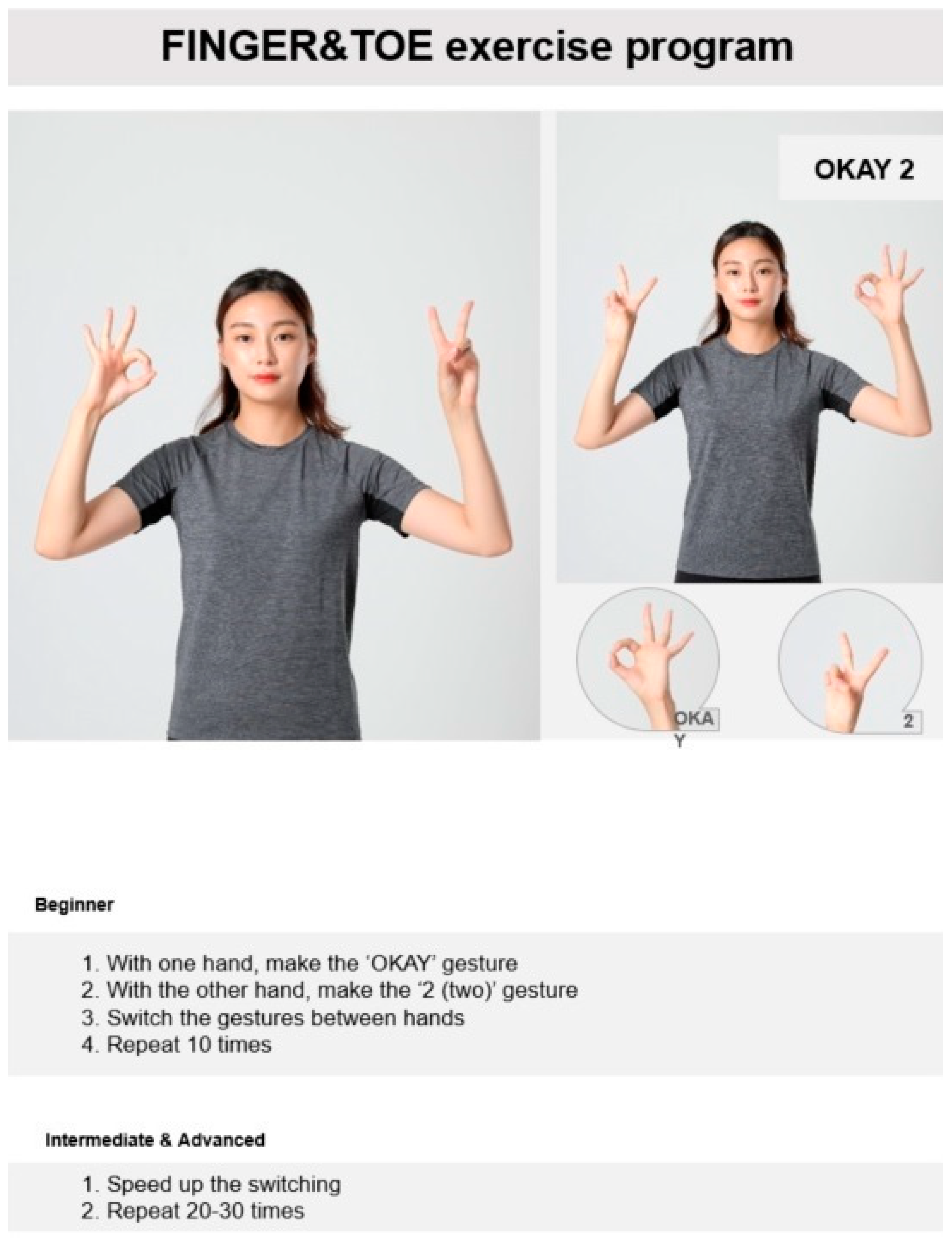

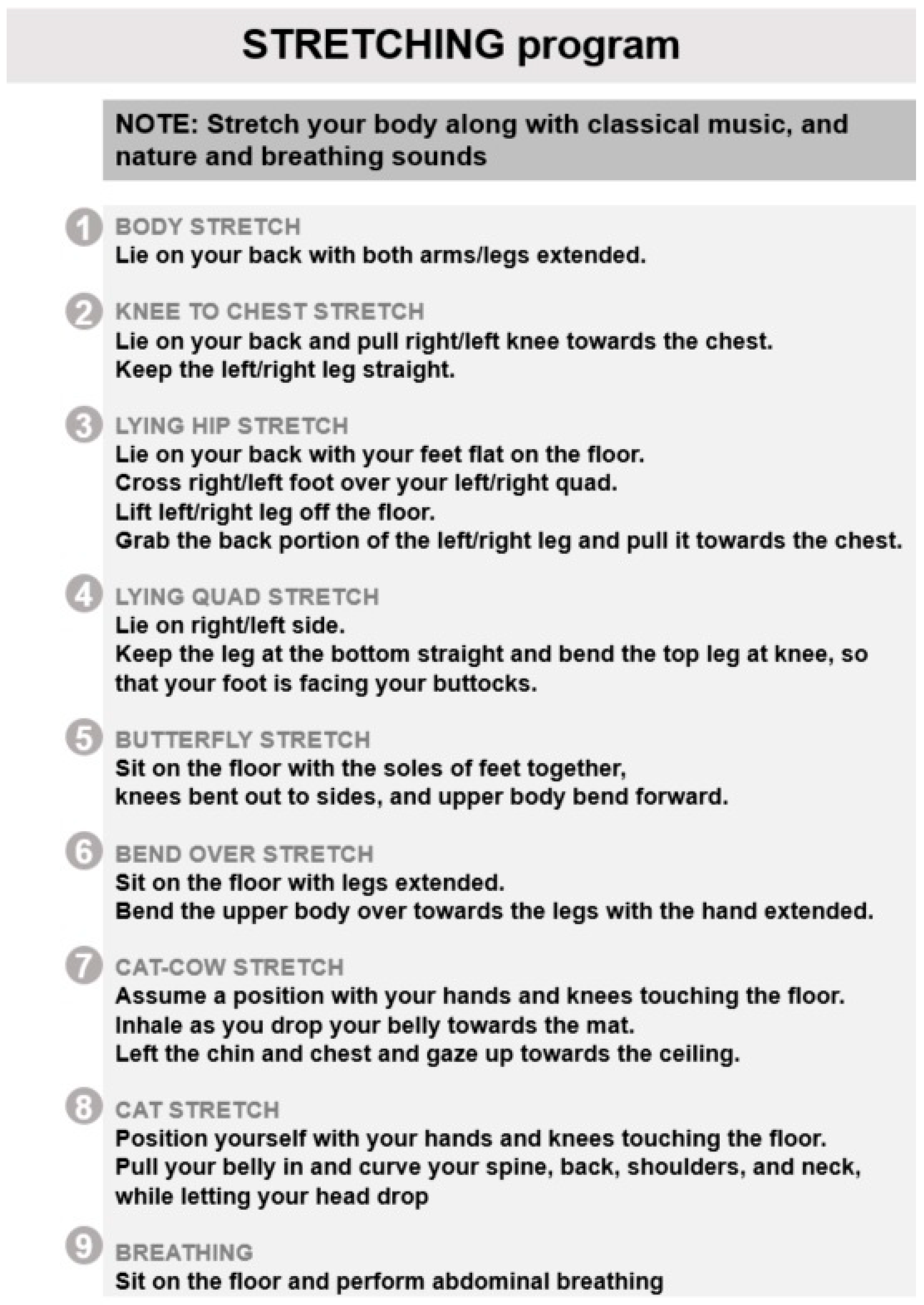
References
- Kim, Y.J.; Han, J.W.; So, Y.S.; Seo, J.Y.; Kim, K.Y.; Kim, K.W. Prevalence and trends of dementia in korea: A systematic review and meta-analysis. J. Korean Med. Sci. 2014, 29, 903–912. [Google Scholar] [CrossRef] [PubMed]
- Chhetri, J.K.; de Souto Barreto, P.; Cantet, C.; Pothier, K.; Cesari, M.; Andrieu, S.; Coley, N.; Vellas, B. Effects of a 3-year multi-domain intervention with or without omega-3 supplementation on cognitive functions in older subjects with increased caide dementia scores. J. Alzheimers Dis. 2018, 64, 71–78. [Google Scholar] [CrossRef] [PubMed]
- Langa, K.M.; Larson, E.B.; Crimmins, E.M.; Faul, J.D.; Levine, D.A.; Kabeto, M.U.; Weir, D.R. A comparison of the prevalence of dementia in the united states in 2000 and 2012. JAMA Intern. Med. 2017, 177, 51–58. [Google Scholar] [CrossRef]
- Larson, E.B.; Yaffe, K.; Langa, K.M. New insights into the dementia epidemic. N. Engl. J. Med. 2013, 369, 2275–2277. [Google Scholar] [CrossRef] [PubMed]
- Lee, Y.; Back, J.H.; Kim, J.; Kim, S.H.; Na, D.L.; Cheong, H.K.; Hong, C.H.; Kim, Y.G. Systematic review of health behavioral risks and cognitive health in older adults. Int. Psychogeriatr. 2010, 22, 174–187. [Google Scholar] [CrossRef] [PubMed]
- Matthews, F.E.; Arthur, A.; Barnes, L.E.; Bond, J.; Jagger, C.; Robinson, L.; Brayne, C. Medical Research Council Cognitive Function; Ageing Collaboration. A two-decade comparison of prevalence of dementia in individuals aged 65 years and older from three geographical areas of england: Results of the cognitive function and ageing study i and ii. Lancet 2013, 382, 1405–1412. [Google Scholar] [PubMed]
- Ngandu, T.; Lehtisalo, J.; Solomon, A.; Levalahti, E.; Ahtiluoto, S.; Antikainen, R.; Backman, L.; Hanninen, T.; Jula, A.; Laatikainen, T.; et al. A 2 year multidomain intervention of diet, exercise, cognitive training, and vascular risk monitoring versus control to prevent cognitive decline in at-risk elderly people (finger): A randomised controlled trial. Lancet 2015, 385, 2255–2263. [Google Scholar] [CrossRef]
- Norton, S.; Matthews, F.E.; Barnes, D.E.; Yaffe, K.; Brayne, C. Potential for primary prevention of alzheimer’s disease: An analysis of population-based data. Lancet Neurol. 2014, 13, 788–794. [Google Scholar] [CrossRef]
- Satizabal, C.L.; Beiser, A.S.; Chouraki, V.; Chene, G.; Dufouil, C.; Seshadri, S. Incidence of dementia over three decades in the framingham heart study. N. Engl. J. Med. 2016, 374, 523–532. [Google Scholar] [CrossRef]
- Schrijvers, E.M.; Verhaaren, B.F.; Koudstaal, P.J.; Hofman, A.; Ikram, M.A.; Breteler, M.M. Is dementia incidence declining? Trends in dementia incidence since 1990 in the rotterdam study. Neurology 2012, 78, 1456–1463. [Google Scholar] [CrossRef]
- Park, H.K.; Jeong, J.H.; Moon, S.Y.; Park, Y.K.; Hong, C.H.; Na, H.R.; Song, H.S.; Lee, S.M.; Choi, M.; Park, K.W.; et al. South korean study to prevent cognitive impairment and protect brain health through lifestyle intervention in at-risk elderly people: Protocol of a multicenter, randomized controlled feasibility trial. J. Clin. Neurol. 2020, 16, 292–303. [Google Scholar] [CrossRef] [PubMed]
- Gomes-Osman, J.; Cabral, D.F.; Morris, T.P.; McInerney, K.; Cahalin, L.P.; Rundek, T.; Oliveira, A.; Pascual-Leone, A. Exercise for cognitive brain health in aging: A systematic review for an evaluation of dose. Neurol. Clin. Pract. 2018, 8, 257–265. [Google Scholar] [CrossRef] [PubMed]
- Kim, J.H.; Go, S.M.; Seo, S.W.; Kim, S.H.; Chin, J.; Moon, S.Y.; Lim, H.; Cheong, H.K.; Choi, S.A.; Lee, J.H.; et al. Survival in subcortical vascular dementia: Predictors and comparison to probable alzheimer’s disease in a tertiary memory clinic population. Dement. Geriatr Cogn. Disord. 2015, 40, 210–221. [Google Scholar] [CrossRef] [PubMed]
- Han, C.; Jo, S.A.; Jo, I.; Kim, E.; Park, M.H.; Kang, Y. An adaptation of the korean mini-mental state examination (k-mmse) in elderly koreans: Demographic influence and population-based norms (the age study). Arch. Gerontol. Geriatr. 2008, 47, 302–310. [Google Scholar] [CrossRef]
- Bull, F.C.; Maslin, T.S.; Armstrong, T. Global physical activity questionnaire (gpaq): Nine country reliability and validity study. J. Phys. Act. Health 2009, 6, 790–804. [Google Scholar] [CrossRef] [PubMed]
- WHO. Global Recommendations on Physical Activity for Health 18–64 Years Old; Media. Center. News Release; WHO: Geneva, Switzerland, 2011. [Google Scholar]
- Jeong, G.W.; Kim, Y.J.; Park, S.; Kim, H.; Kwon, O. Associations of recommended food score and physical performance in korean elderly. BMC Public Health 2019, 19, 128. [Google Scholar] [CrossRef]
- Park, H.; Park, W.; Lee, M.; Ko, N.; Kim, E.; Ishikawa-Takata, K.; Park, J. The association of locomotive and non-locomotive physical activity measured by an accelerometer with functional fitness in healthy elderly men: A pilot study. J. Exerc. Nutr. Biochem. 2018, 22, 41–48. [Google Scholar] [CrossRef]
- Walters, K.; Frost, R.; Kharicha, K.; Avgerinou, C.; Gardner, B.; Ricciardi, F.; Hunter, R.; Liljas, A.; Manthorpe, J.; Drennan, V.; et al. Home-based health promotion for older people with mild frailty: The homehealth intervention development and feasibility rct. Health Technol. Assess. 2017, 21, 1–128. [Google Scholar] [CrossRef]
- Doody, R.S.; Ferris, S.H.; Salloway, S.; Sun, Y.; Goldman, R.; Watkins, W.E.; Xu, Y.; Murthy, A.K. Donepezil treatment of patients with mci: A 48-week randomized, placebo-controlled trial. Neurology 2009, 72, 1555–1561. [Google Scholar] [CrossRef]
- Choi, S.H.; Shim, Y.S.; Ryu, S.H.; Ryu, H.J.; Lee, D.W.; Lee, J.Y.; Jeong, J.H.; Han, S.H. Validation of the literacy independent cognitive assessment. Int. Psychogeriatr. 2011, 23, 593–601. [Google Scholar] [CrossRef]
- Bae, J.N.; Cho, M.J. Development of the korean version of the geriatric depression scale and its short form among elderly psychiatric patients. J. Psychosom. Res. 2004, 57, 297–305. [Google Scholar] [CrossRef] [PubMed]
- Guralnik, J.M.; Simonsick, E.M.; Ferrucci, L.; Glynn, R.J.; Berkman, L.F.; Blazer, D.G.; Scherr, P.A.; Wallace, R.B. A short physical performance battery assessing lower extremity function: Association with self-reported disability and prediction of mortality and nursing home admission. J. Gerontol. 1994, 49, M85–M94. [Google Scholar] [CrossRef] [PubMed]
- Morris, J.C. The clinical dementia rating (cdr): Current version and scoring rules. Neurology 1993, 43, 2412–2414. [Google Scholar] [CrossRef] [PubMed]
- Suttanon, P.; Hill, K.D.; Said, C.M.; Williams, S.B.; Byrne, K.N.; LoGiudice, D.; Lautenschlager, N.T.; Dodd, K.J. Feasibility, safety and preliminary evidence of the effectiveness of a home-based exercise programme for older people with alzheimer’s disease: A pilot randomized controlled trial. Clin. Rehabil. 2013, 27, 427–438. [Google Scholar] [CrossRef] [PubMed]
- Kivipelto, M.; Mangialasche, F.; Ngandu, T.J.N.R.N. Lifestyle interventions to prevent cognitive impairment, dementia and alzheimer disease. Nat. Rev. Neurol. 2018, 14, 653–666. [Google Scholar] [CrossRef]
- Kivipelto, M.; Ngandu, T.; Laatikainen, T.; Winblad, B.; Soininen, H.; Tuomilehto, J. Risk score for the prediction of dementia risk in 20 years among middle aged people: A longitudinal, population-based study. Lancet Neurol. 2006, 5, 735–741. [Google Scholar] [CrossRef]
- Rosenberg, A.; Ngandu, T.; Rusanen, M.; Antikainen, R.; Bäckman, L.; Havulinna, S.; Hänninen, T.; Laatikainen, T.; Lehtisalo, J.; Levälahti, E.; et al. Multidomain lifestyle intervention benefits a large elderly population at risk for cognitive decline and dementia regardless of baseline characteristics: The finger trial. Alzheimer’s & Dementia 2018, 14, 263–270. [Google Scholar]
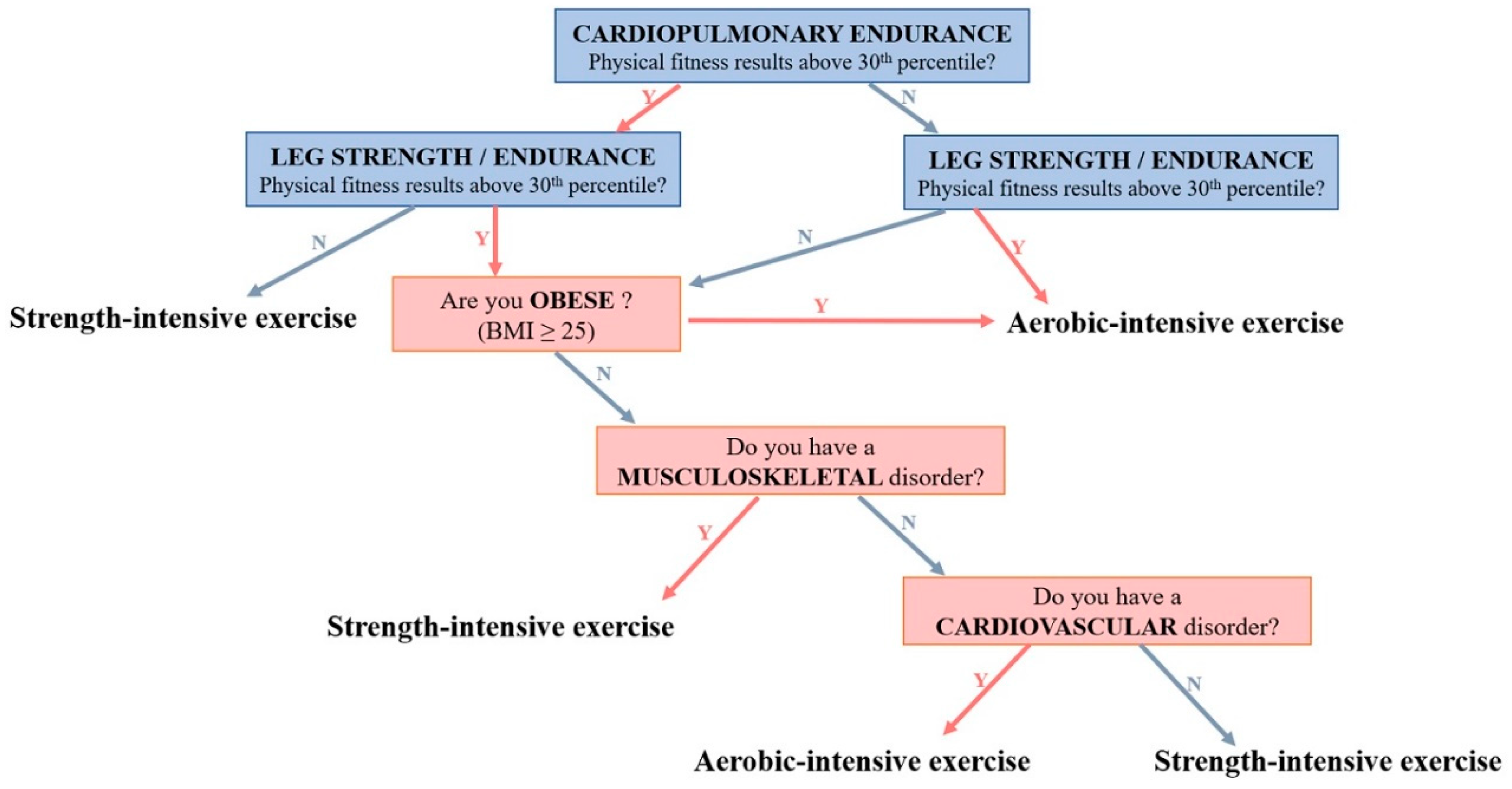
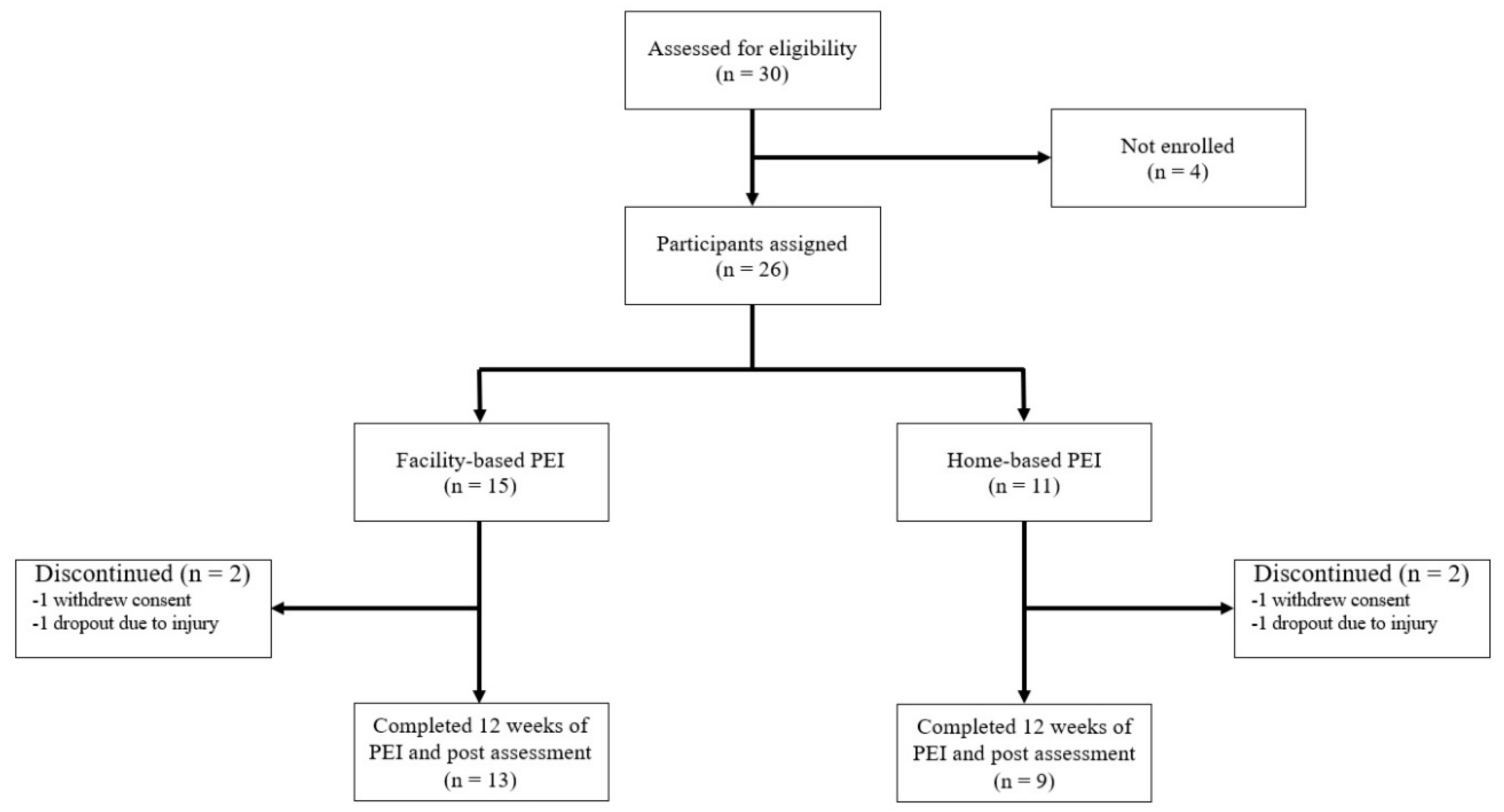
| Weeks 0–4 | Weeks 5–8 | Weeks 9–12 | |
|---|---|---|---|
| Structured exercise program | Level 1 | Level 2 | Level 3 |
| Exercise frequency, per week | 3 | 3 | 3 |
| Percentage of maximum heart rate | 40–50% | 45–55% | 50–60% |
| Duration of exercise (minutes/session) | 60 | 60 | 60 |
| Resistance exercise (minutes/session) | 20–25 | 20–25 | 20–25 |
| Muscle groups, n | 10 | 12 | 15 |
| Sets, n | 1–2 | 1–3 | 2–4 |
| Aerobic exercise (minutes/session) | 20–25 | 20–25 | 20–25 |
| Balance exercise (minutes/session) | 5 | 5 | 5 |
| Finger-and-toe movements (minutes/session) | 5 | 5 | 5 |
| Stretching exercise (minutes/session) | 5 | 5 | 5 |
| Variable | Total (n = 26) | Facility-Based (n = 15) | Home-Based (n = 11) |
|---|---|---|---|
| Age, years | 67.9 ± 3.6 | 67.3 ± 3.8 | 68.3 ± 3.2 |
| Sex, female, n (%) | 22 (84.6%) | 14 (93.3%) | 8 (72.7%) |
| Education, years | 11.6 ± 4.0 | 10.5 ± 3.2 | 13.0 ± 4.7 |
| Hypertension, n (%) | 12 (46.2%) | 4 (26.7%) | 8 (72.7%) |
| Hypercholesterolemia, n (%) | 6 (23.1%) | 6 (40.0%) | 0 (0.0%) |
| Diabetes mellitus, n (%) | 4 (15.4%) | 3 (20.0%) | 1 (9.1%) |
| Musculoskeletal disease, n (%) | 6 (23.1%) | 1 (6.7%) | 5 (45.5%) |
| Body mass index | 23.7 ± 2.7 | 23.0 ± 2.7 | 24.5 ± 2.7 |
| K-MMSE | 27.3 ± 1.5 | 27.0 ± 1.5 | 27.8 ± 1.5 |
| CDR | |||
| 0, n (%) | 14 (53.8%) | 8 (53.3%) | 6 (54.5%) |
| 0.5, n (%) | 12 (46.2%) | 7 (46.7%) | 5 (45.5%) |
| GPAQ, MVPA (min/week) | 366.5 ± 310.1 | 326.0 ± 246.8 | 421.8 ± 386.4 |
| Weeks 1–3 | Weeks 4–6 | Weeks 7–9 | Weeks 10–12 | Total | |
|---|---|---|---|---|---|
| Facility-based PEI | 92.3 | 90.4 | 86.3 | 84.6 | 88.3 |
| Home-based PEI | 32.1 | 64.2 | 71.6 | 81.5 | 62.3 |
| Variable | Facility-Based (n = 13) | Home-Based (n = 9) | ||||||
|---|---|---|---|---|---|---|---|---|
| Pre | Post | t | p-Value | Pre | Post | t | p-Value | |
| Cognition | ||||||||
| K-MMSE | 27.1 ± 1.6 | 26.5 ± 2.0 | 0.846 | 0.414 | 27.9 ± 1.6 | 27.7 ± 1.9 | 0.555 | 0.594 |
| ADAS-Cog, total score | 11.6 ± 4.2 | 9.2 ± 3.7 | 3.121 | 0.009 | 8.8 ± 4.2 | 8.1 ± 4.7 | 0.784 | 0.455 |
| LICA, word delayed recall | 7.8 ± 2.8 | 8.9 ± 0.9 | −1.656 | 0.124 | 8.7 ± 1.4 | 9.0 ± 1.4 | −1.000 | 0.347 |
| LICA, story delayed recall | 12.0 ± 5.1 | 14.8 ± 2.6 | −2.531 | 0.026 | 12.5 ± 4.4 | 13.0 ± 4.8 | −0.418 | 0.687 |
| LICA, stick reconstruction | 16.8 ± 1.7 | 15.3 ± 6.4 | 0.830 | 0.420 | 17.1 ± 0.9 | 14.1 ± 7.0 | 1.364 | 0.202 |
| SGDS-K | 1.0 ± 1.3 | 0.8 ± 1.3 | 0.485 | 0.636 | 0.9 ± 1.3 | 0.3 ± 0.7 | 1.474 | 0.179 |
| Physical performance | ||||||||
| Body mass index | 23.0 ± 2.7 | 23.6 ± 2.9 | −3.150 | 0.008 | 24.1 ± 2.8 | 24.7 ± 3.3 | −3.155 | 0.014 |
| Grip test, left (kg ) | 24.4 ± 3.3 | 24.4 ± 3.6 | −0.080 | 0.937 | 24.5 ± 7.1 | 24.6 ± 6.1 | −0.029 | 0.978 |
| Grip test, right (kg) | 24.7 ± 3.5 | 24.3 ± 3.8 | 0.853 | 0.410 | 24.1 ± 6.3 | 25.1 ± 5.6 | −1.737 | 0.121 |
| Relative grip strength (%) | 45.4 ± 5.4 | 43.9 ± 5.7 | 1.921 | 0.079 | 43.1 ± 11.2 | 43.2 ± 10.5 | −0.104 | 0.920 |
| 30 s sit–stand test (times) | 20.6 ± 3.0 | 23.7 ± 3.7 | −3.945 | 0.002 | 18.9 ± 4.3 | 23.2 ± 3.9 | −4.526 | 0.002 |
| 3 m sit–walk-and-return test (sec) | 4.7 ± 0.7 | 4.9 ± 0.7 | −2.386 | 0.034 | 4.8 ± 0.6 | 5.0 ± 0.6 | −2.144 | 0.064 |
| Sit-and-reach test (cm) | 16.6 ± 7.4 | 18.2 ± 6.5 | −1.501 | 0.159 | 10.5 ± 12.5 | 11.6 ± 9.7 | −0.766 | 0.466 |
| 2 min stationary march (times) | 109.3 ± 13.8 | 120.8 ± 15.7 | −4.488 | 0.001 | 104.7 ± 14.5 | 120.3 ± 19.0 | −2.841 | 0.022 |
| * Figure-8-walks (sec) | 24.7 ± 3.7 | 23.7 ± 3.5 | 1.864 | 0.087 | 24.8 ± 3.9 | 24.8 ± 3.5 | −0.035 | 0.973 |
© 2020 by the authors. Licensee MDPI, Basel, Switzerland. This article is an open access article distributed under the terms and conditions of the Creative Commons Attribution (CC BY) license (http://creativecommons.org/licenses/by/4.0/).
Share and Cite
Lee, S.M.; Song, H.-s.; Chun, B.-O.; Choi, M.; Sun, K.; Kim, K.S.; Jeon, H.; Seo, D.E.; Kwon, H.M.; Jeong, J.H.; et al. Feasibility of a 12 Week Physical Intervention to Prevent Cognitive Decline and Disability in the At-Risk Elderly Population in Korea. J. Clin. Med. 2020, 9, 3135. https://doi.org/10.3390/jcm9103135
Lee SM, Song H-s, Chun B-O, Choi M, Sun K, Kim KS, Jeon H, Seo DE, Kwon HM, Jeong JH, et al. Feasibility of a 12 Week Physical Intervention to Prevent Cognitive Decline and Disability in the At-Risk Elderly Population in Korea. Journal of Clinical Medicine. 2020; 9(10):3135. https://doi.org/10.3390/jcm9103135
Chicago/Turabian StyleLee, Sun Min, Hong-sun Song, Buong-O Chun, Muncheong Choi, Kyunghwa Sun, Ki Sub Kim, Hyesu Jeon, Da Eun Seo, Hye Mi Kwon, Jee Hyang Jeong, and et al. 2020. "Feasibility of a 12 Week Physical Intervention to Prevent Cognitive Decline and Disability in the At-Risk Elderly Population in Korea" Journal of Clinical Medicine 9, no. 10: 3135. https://doi.org/10.3390/jcm9103135
APA StyleLee, S. M., Song, H.-s., Chun, B.-O., Choi, M., Sun, K., Kim, K. S., Jeon, H., Seo, D. E., Kwon, H. M., Jeong, J. H., Park, Y. K., Hong, C. H., Na, H. R., Choi, S. H., & Moon, S. Y. (2020). Feasibility of a 12 Week Physical Intervention to Prevent Cognitive Decline and Disability in the At-Risk Elderly Population in Korea. Journal of Clinical Medicine, 9(10), 3135. https://doi.org/10.3390/jcm9103135






